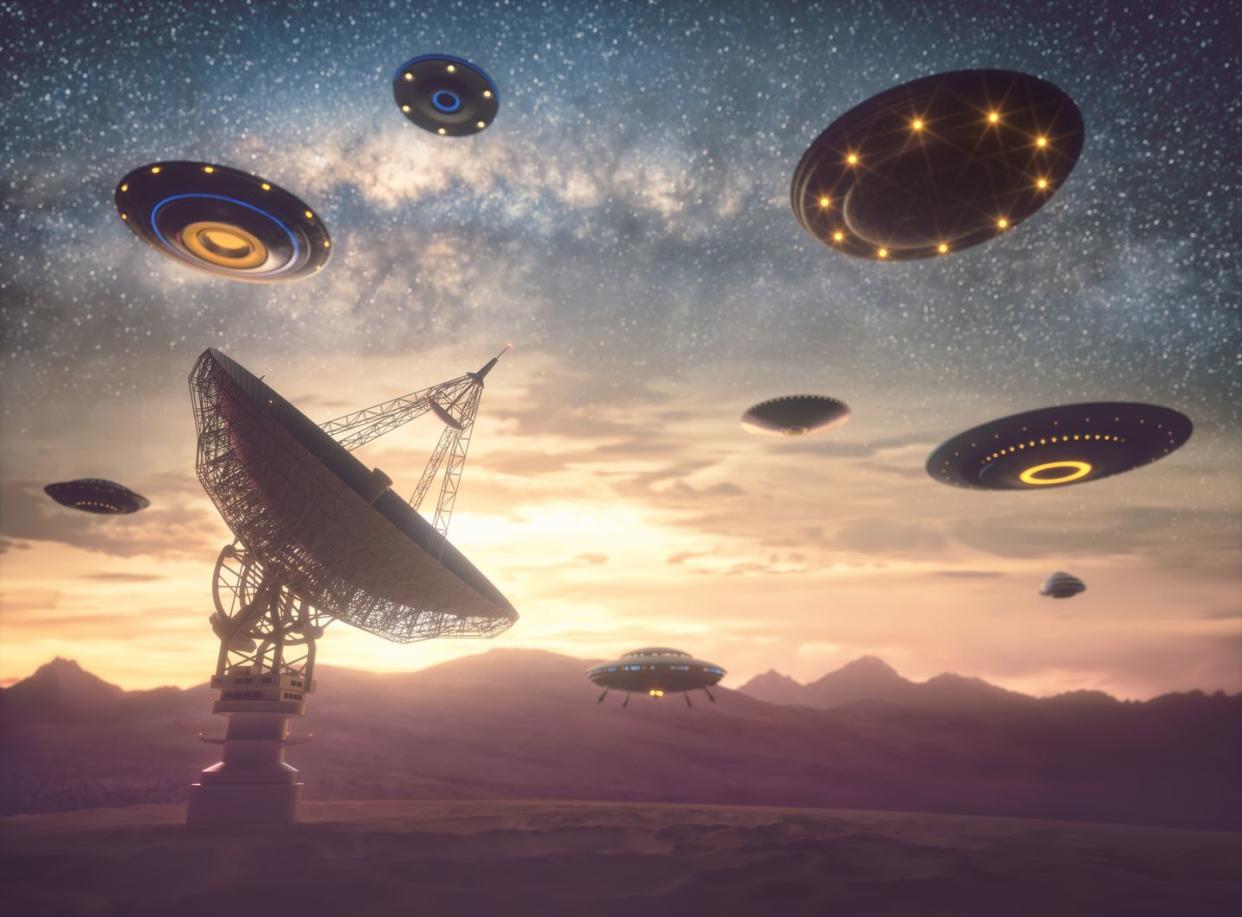Aliens Could Send Us Quantum Messages From Space, Physicists Say

Are we ready to receive quantum messages from outer space? Research says yes.
On Earth, quantum communications happens via satellite or fiber-optic cable networks.
Space has fewer obstacles, so coherent signals can travel much, much further.
Alien civilizations could potentially send quantum messages across a vast distance through space—something we might eventually be able to do, too, according to new research from the University of Edinburgh in Scotland. To understand how this could work, we need to do a little digging into quantum phenomena and how quantum networks have emerged on Earth. What are the perils and strengths of quantum communication in these two very different environs?
Physicists Arjun Berera and Jaime Calderón-Figuero wrote the new paper, published late last month in the journal Physical Review D, as a literature review (meaning they checked out the existing research) and a thought exercise about one potential version of interstellar communication. They found that the same quantum phenomena that cohere over smaller networks here on Earth could be used across wide swaths of space; instead of relying on a more traditional medium like fiber optic cable, these messages could be sent through the air (or in the absence of air) itself.
Their calculations show that photon beams can travel far enough to cross the entire Milky Way galaxy, which means the messages could be all around us if we just knew how to listen. The scientists determined that while these messages would be affected by gravity during their long trip across the galaxy, they would not “decohere,” a key term that means quantum phenomena have fallen out of the delicate quantum state. The message might be warped, but they would still be legible. The scientists found that photons in the optical spectrum (meaning the visible light colors) would be less affected by gravity than those in the invisible X-ray range; but it would be easier to detect repeating messages in the X-ray range, making those a better candidate.
Quantum communications on the ground and in space have one critical thing in common: They rely on a quantum state called entanglement. For help understanding, we spoke with David Awschalom, a decorated physicist who leads the Chicago Quantum Exchange. “It’s not that you’re just trying to send info from one place to another,” he explains. “You’re taking a piece of information and having it encompass two spatially separate locations.”
In this case, that means locations many light-years apart. People “viewing” each end of the entangled particles would see the exact same information. (Curiously, while the information updates instantly, it can only be viewed after the speed of light, like hearing the sonic boom of thunder after seeing the lightning.) Particles in the entangled quantum state act as a group, share information as a group, and are intrinsically linked.
👽 About Those Messages to Space ...
NASA Wants to Beam a Message to Aliens, But It Could Give Away Humanity’s Greatest Secrets
4 Malicious Alien Civilizations Could Live in Our Galaxy, Scientist Says
Alien Dreams Dashed: Study Says Aliens Potentially 400,000 Years Away
Think of the quantum entanglement state like the delicate film on one of those enormous bubble dippers. When all the particles in the detergent mixture cohere, they can do miraculous-seeming things. But as soon as anything disrupts any part of the film, the entire effect is destroyed. On Earth, entangled photons are protected inside of fiber-optic networks. Fiber optic works by bouncing beams of light along “cores” made of glass or plastic, whether in thin, single-mode cables or thicker multimode cables. That means the medium is glass on Earth, but thin air (or no air at all) in space.
If you’re thinking sending beams through glass instead of air is probably a lot more challenging in terms of resistance and throughput, you’re right. That’s one reason why fiber-optic networks, and virtually all communications networks, end up using a type of technology called a repeater. This is a device that’s usually built into the network infrastructure and absorbs and boosts whatever signals are coming, and they apply to wired as well as wireless internet, for example. (They’re even on the way for wireless electricity!)
It’s not that easy in the quantum realm, though. How do you “repeat” a single photon in an entangled state when the very act of looking at it disrupts the state, as dictated by the observer effect that undergirds quantum physics? (In fact, this is one reason quantum entanglement has such rich applications in security: information can be stored in a way that innately self-destructs if any observer intercepts it.) In space, there’s no option for a repeater. Thankfully, there’s also really no need.
“Sending light through space tends to a large degree sort of obviate this problem,” Awschalom explains. Air or lack of air is an easier medium with less resistance, but there are still challenges. “If you go past our atmosphere and you’re in space, what could deteriorate quantum and optical signals going through the vacuum of space? The impacts there are things like gravity, interstellar particles like dust, things that could scatter the light, like shining a flashlight into a very slightly dusty room.”

This is why the researchers from Edinburgh focused on fidelity of signal and how to best receive the wobbling photons from outer space. In outer space, their issue isn’t really decoherence, which is the biggest enemy of a quantum data network of any kind, when particles fall out of the quantum state and the connection is destroyed. And what wavelength you choose matters because of the properties those wavelengths have, like the way X-rays can pass through most of the human body, versus optical light that casts a shadow instead.
In fiber-optic networks, signals are contained physically, because they bounce within the topology of the cabling. Single-mode cabling gives the signal less room to bounce, meaning it can travel farther without degrading and losing oomph than multimode cabling. In space, there’s no bounce, but that also means there’s no containment. The photons can fly any which way as pushed and pulled by gravity. And in the air on and around Earth, there are other risks, like humidity; imagine shining a light into fog. A successful quantum signal would need to work like your car’s special fog lamps, trying to skirt around the humid cloud to avoid scattering the light.
There is already precedent for sending quantum signals through the air using satellites, Awschalom says. The Chinese satellite Micius, for instance, has sent signals over quite long distances to and from the outermost extent of Earth’s atmosphere in low-Earth orbit. And if stations to send these signals are positioned on high points like mountains, they can avoid a lot of the problems associated with higher humidity.
Awschalom thinks that the future of implemented quantum data networks will involve a multimedia approach, literally, because air and fiber are different mediums. Almost all existing communications (and utilities!) work like large trees or fractals, where thick trunks connect the largest areas of population and then branch into smaller and smaller delivery systems. The trunk of a quantum communications network might be satellite-based, Awschalom says, while cities can network their infrastructure of homes and businesses using fiber instead.
It’s all a matter of finding the best way to keep photons entangled. “Every photon matters,” Awschalom says.
You Might Also Like
